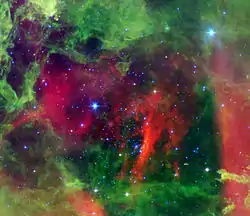NGC 2244
NGC 2244 (also known as Caldwell 50 or the Satellite Cluster) is an open cluster in the Rosette Nebula, which is located in the constellation Monoceros. This cluster has several O-type stars, super hot stars that generate large amounts of radiation and stellar wind.
| NGC 2244 | |
|---|---|
 | |
| Observation data (J2000 epoch) | |
| Right ascension | 6h 31m 54s[1] |
| Declination | +4° 56′[1] |
| Distance | 5.2 kly |
| Apparent magnitude (V) | 4.8[1] |
| Apparent dimensions (V) | 24′ |
| Physical characteristics | |
| Radius | 18 ly[2] |
| Other designations | Caldwell 50, Satellite Cluster,[3] NGC 2239,[4] Cr 99 |
| Associations | |
| Constellation | Monoceros |

The age of this cluster has been estimated to be less than 5 million years. The brightest star in the direction of the cluster is 12 Monocerotis, a foreground K-class giant. The two brightest members of the cluster are HD 46223 of spectral class O4V, 400,000 times brighter than the Sun, and approximately 50 times more massive, and HD 46150, whose spectral type is O5V, has a luminosity 450,000 time larger than that of our star, and is up to 60 times more massive, but it may actually be a double star.[5] These stars do not seem to pulsate, which is in agreement with stellar modeling of stars with similar global parameters.
A study from 2023 found that brown dwarfs in NGC 2244 form closer to OB-stars than to other stars.[6] This could be explained by the photoevaporation of the outer layers of prestellar cores that otherwise would form low-mass stars or intermediate mass stars.[7] The study also found a low disk fraction for low-mass objects of 39±9% for objects later than K0.[6] One cluster member was discovered in the past to show signs of an eroding disk, reminiscent of a proplyd.[8]
See also
References
- "NGC 2244". SIMBAD. Centre de données astronomiques de Strasbourg. Retrieved 2007-04-20.
- distance × sin( angular diameter / 2 )
- "The Rosette Nebula In Hubble Palette". Sky & Telescope. Retrieved 2020-06-23.
- "Notes on the NGC objects, particularly those missing, misidentified, or otherwise unusual (ngcnotes.all)". Historically-aware NGC/IC Positions and Notes. Retrieved 2019-08-11.
- A quantitative study of O stars in NGC 2244 and the Monoceros OB2 association, Martins, F.; Mahy, L.; Hillier, D. J.; Rauw, G., Astronomy and Astrophysics 538, pp. A39, Bibcode:2012A&A...538A..39M, doi:10.1051/0004-6361/201117458.
- Almendros-Abad, V.; Mužić, K.; Bouy, H.; Bayo, A.; Scholz, A.; Peña Ramírez, K.; Moitinho, A.; Kubiak, K.; Schöedel, R.; Barač, R.; Brčić, P.; Ascenso, J.; Jayawardhana, R. (2023-05-01). "Spectroscopic substellar initial mass function of NGC 2244".
{{cite journal}}: Cite journal requires|journal=(help) - Whitworth, A. P.; Zinnecker, H. (2004-11-01). "The formation of free-floating brown dwarves and planetary-mass objects by photo-erosion of prestellar cores". Astronomy and Astrophysics. 427: 299–306. doi:10.1051/0004-6361:20041131. ISSN 0004-6361.
- Balog, Zoltan; Rieke, G. H.; Su, Kate Y. L.; Muzerolle, James; Young, Erick T. (2006-10-01). "Spitzer MIPS 24 μm Detection of Photoevaporating Protoplanetary Disks". The Astrophysical Journal. 650: L83–L86. doi:10.1086/508707. ISSN 0004-637X.
External links
 Media related to NGC 2244 at Wikimedia Commons
Media related to NGC 2244 at Wikimedia Commons- NASA – photo and information on NGC 2244
- Spitzer Space Telescope site – Photo of NGC 2244
- NGC 2244 on WikiSky: DSS2, SDSS, GALEX, IRAS, Hydrogen α, X-Ray, Astrophoto, Sky Map, Articles and images
- SEDS – NGC 2244